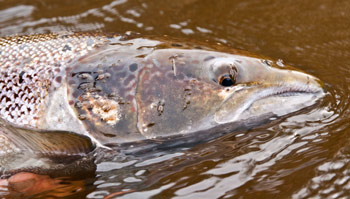Lobsters Sensitive to Salmon Anti-parasitic
by Laurie Schreiber

Parasitic sea lice attached to atlantic salmon above the eye, behind the eye, center, and on the gill cover. The lice have a molt cycle simlar to lobster. Photo courtesy of Inka Milewski, Science Adviser, Canada.
PORTLAND—Studies in Norway are showing that lobster shell formation is affected by a residual anti-parasitic agent used to combat sea lice on salmon farms.
At the 11th International Conference on Lobster Biology and Management—hosted in Portland from June 4-9 by the University of Maine and Boston University—Carly Daniels of The National Lobster Hatchery in Padstow, England presented findings compiled by Ole Samuelsen of the Institute of Marine Research in Bergen, Norway. Samuelsen’s research studied sensitivity during the molting cycle in European lobster juveniles to the anti-parasitic agent teflubenzuron.
Sea lice is the biggest problem Norway has with respect to its salmon farms, said Daniels. Sea lice is a crustacean, and teflubenzuron affects its chitin. Thus, she said, it made sense to research to what extent the chemical was affecting lobsters.
According to Samuelsen’s abstract, teflubenzuron’s use has increased in recent years in Norway. It acts as a chitin inhibitor and is especially effective on the copepodite stages of sea lice. The drug is added to salmon feed and, through feed spill and feces, the chemical can spread to the surrounding environment and potentially affect non-target crustaceans.
In the study, Samuelsen’s team followed 37 European lobster juveniles through one molt cycle to assess their sensitivity to teflubenzuron. The lobster juveniles were monitored before the experiment started to obtain information of the length of the molting cycle. Juveniles were separated into six groups, signifying different phases in the cycle. They were fed concentrations of teflubenzuron that simulated fecal concentrations from treated salmon. The experiment lasted 170 days to capture at least two molts.
“Mortality was 100 percent within 14 days in the group with juveniles given the medicated pellet 1-3 days before scheduled molting,” the abstract says. “For the juveniles given the medicated pellet 1-2 days after molting, mortality was 28.6 percent. However, these juveniles did not die until they molted for the second time, 120 days after ingestion of teflubenzuron feed. No mortality was found in the groups 20 percent and 40 percent into the scheduled molting cycle, indicating no or little chitin production in these phases. However, when the juveniles were 60 percent and 80 percent into the scheduled molting, mortality was found to be 33 percent and 67% respectively.”
Deformities were also recorded, including twisted walking legs, stiff abdomen, and swollen carapace.
“The findings clearly show that European lobster is highly sensitive to teflubenzuron, particularly just before molting,” the abstract says.
“Does the molting cycle matter? Absolutely,” said Daniels, who said that further research will focus on uncovering the concentration of the chemical that’s killing the animals.
